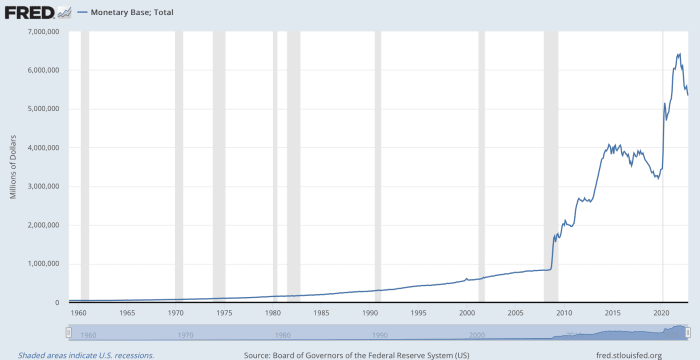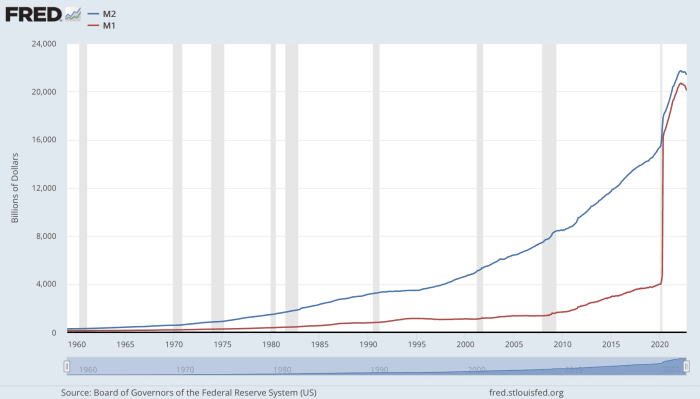
The Federal Reserve can increase the supply of money in circulation by buying government securities.
What Is Money Supply?
Money supply represents the total amount of money in circulation, including cash, coins, account balances held in banks, and funds that aren’t quickly transferable into cash. Since the collapse of the Bretton Woods system in the 1970s and the abandonment of the gold standard, the U.S. dollar and many countries’ currencies became fiat currencies (government-issued currency not pegged to a commodity), and more money has been put into circulation.
Who Controls the Money Supply?
A nation’s central bank typically controls its money supply. In the U.S., the Federal Reserve oversees a portion of money known as the monetary base, which forms its balance sheet.
What Are the Types of Money Supply?
Money in circulation in the form of the monetary base represents the most liquid of assets. But there are other types of money held in different types of accounts that aren’t quickly transferable into cash, and these are categorized as M1 and M2.
Monetary Base
The monetary base represents currency in circulation and the deposit balances that depository institutions hold with the Fed. The Fed increases or decreases the monetary base by buying or selling securities in the open market.
For example, the Fed buys U.S. bonds with a check that is deposited at a bank, which has an account with the Fed. The amount on the check adds to the Fed’s reserves, and that increases the monetary base. The monetary base decreases when the Fed sells bonds and gets a check from a bank. When that check is deposited, the bank’s balance with the Fed decreases.
The monetary base, often referred to as M0, serves as the Fed’s balance sheet.
M1
M1 is a broader version of the money supply. It includes the monetary base and other types of money, namely checkable—or demand—deposits, and traveler’s checks. Demand deposits and traveler’s checks, though, require time to convert into cash aren’t as easy to liquidate as currency and coins.
M2
M2 consists of M1 plus savings deposits, time deposits, and retail money market funds. Time deposits are typically in amounts less than $100,000.
M3
M3 includes M2 but has broader measures of money supply, including institutional money market mutual funds and repurchase agreements. The Fed discontinued publishing data on M3 in 2006, saying that M3 offered little more additional information on economic activity than M2 conveyed, and it no longer played a role in its decision-making on monetary policy.
How Does Money Supply Work?
There are various ways in which the amount of money circulating in the economy can change.
Money supply can increase when banks take in deposits and they use some of the deposits as loans. This is also known as fractional lending.
One way the Fed can quickly increase the money supply is by buying government securities issued by the U.S. Treasury. The value of securities purchased can sometimes run into the tens of billions of dollars, pumping large amounts of cash into the financial system.
For example, when the Fed decides to buy $1 billion in 10-year bonds from a bank that is a primary dealer, money is essentially created, and that $1 billion is transferred to the bank’s reserve account. Still, that amount of money is recorded onto the Fed’s balance sheet.
Example: Financial Crisis of 2007–2008
Following the financial crisis of 2007–2008, to keep the financial system afloat and to prevent the economy from collapsing, the Fed embarked on a buying program known as quantitative easing (QE). As shown in the graphs below, the monetary base climbed from about $850 billion before QE in August 2008 to $6.4 trillion after QE in December 2021—representing a 7.5-fold increase and the greatest expansion of money in U.S. history.
M1 and M2—broader categories of money supply—exceeded $20 trillion in 2021. To decrease the money supply, the Fed could buy back those securities, in what’s known as quantitative tightening.

The aftermath of the financial crisis of 2007–08 saw the greatest creation of dollars in U.S. history.
Example: Lessons From the Great Depression
The Fed learned from its mistakes during the Great Depression when money wasn’t circulating in the financial system. Banks had collapsed due to their exposure to the stock market, and there was no federal guarantee on deposits. Account holders suddenly saw their wealth disappear, and the amount of money in circulation declined.
With money supply down, economic growth faltered, unemployment soared, deflation occurred, manufacturing output dropped, and the value of the dollar declined. Credit was also difficult to access, making it difficult for businesses to invest and for many Americans to spend.
The Fed failed to save the faltering economy by not increasing the money supply through open market operations and not trying to prevent banks from going under. The central bank avoided making that same mistake following the 2007–08 financial crisis by increasing the money supply via quantitative easing.
Frequently Asked Questions (FAQ)
The following are answers to some of the most common questions investors ask about the money supply.
How Does Money Supply Affect the Economy and Inflation?
When more money is injected into the financial system, spending is stimulated, and this can in turn boost the economy. However, too much money entering the system too quickly could cause inflation to accelerate.
What Is Not Included in Money Supply?
Foreign currency that is in people’s hands isn’t part of a nation’s money supply. In fact, countries typically only monitor their own currency. Gold stored as bullion in bank vaults also isn’t counted as part of money supply, but minted gold coins are.
Read More:What Is Money Supply? Definition & Historical Examples
2022-11-24 00:01:00

